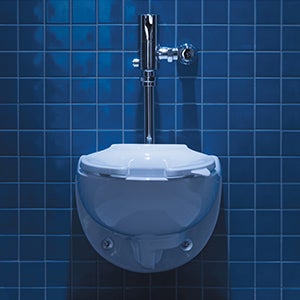Plumbing manufacturers target health care needs
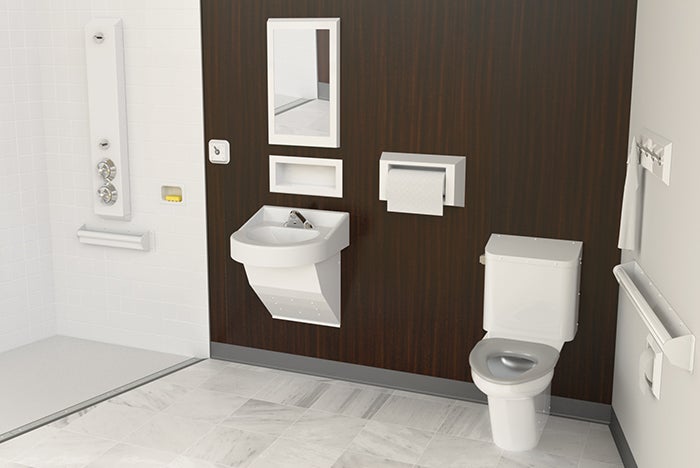
Image courtesy of Whitehall Manufacturing, a division of Morris Group International
Manufacturers seeking to supply plumbing products to health care facilities face many challenges. Safety, sustainability, durability and aesthetic considerations all play important roles in a health facility professional’s purchasing decisions.
As demonstrated by many recent product introductions targeting the health care field, however, the nation’s plumbing manufacturers have been taking note. Many current plumbing product trends are geared specifically to these and other health care concerns.
Designs and materials
Among these trends are new designs and materials that promote infection prevention, durability, tamper-resistance and water conservation. Likewise, development of sensor-actuated faucets, valves and dispensers continues. Vendors also are manufacturing more residential-looking fixtures while striving to accommodate people of all sizes.
Additionally, manufacturers are cultivating technological advances that limit germs and make cleaning easier, according to Kris Alderson, senior marketing manager, Bradley Corp., Menomonee Falls, Wis. “They are looking for ways to promote better hygiene while providing an attractive and welcoming washroom experience in patient areas and public-facing spaces.”
As part of this trend, hands-free faucet designs with minimal crevices help reduce the spread of infections in health care settings. New sink designs that minimize splashing during hand washing and the use of offset drains and deep, sloping profiles are another way to improve safety and maintain infection control. Also, special surface finishes inhibit the growth of stain- and odor-causing bacteria, mold and mildew.
Faucets and showers with thermostatic temperature controls help prevent scalding. “The newest commercial faucets from American Standard feature the SmarTherm Safety Shut-Off, which incorporates an ASSE 1070-certified thermostatic hot water temperature limiter directly into the faucet spout, eliminating the need to specify and install a separate thermostatic mixing valve,” says Tony D’Amato, senior product manager for commercial fittings, LIXIL Americas, home to American Standard brands, DXV and Grohe, Piscataway, N.J.
Vendors also are adding features such as auto-purge to prevent water from becoming stagnant as well as ceramic cartridges in manual faucets that offer durability. “T&S ceramic cartridges come with a lifetime warranty,” says David Scelsi, product marketing manager, T&S Brass, Travelers Rest, S.C. “For infection control, we are seeing more antimicrobial coatings, which prevent microbes from growing on faucet surfaces, thus reducing the potential for contamination. Vandal-resistant screws and aerators also are popular to prevent tampering that can negate water-saving efforts.”
Water conservation is another goal of manufacturers. Conservation options for the health care field include hydrogenerators that can be paired with sensor faucets. “They harness the energy created by flowing water, converting energy from mechanical to electrical as water passes through a high-efficiency turbine. This energy is stored and used to power the faucet, which eliminates the need for batteries and does not require the faucet to be hardwired into the building,” Scelsi explains.
Hospitals require a high flow rate of water to effectively perform intended processes using commercially available plumbing designs, according to Charles Scott, senior product manager, commercial fixtures, Kohler Co., Kohler, Wis. “A water savings of nearly 30 percent is possible through proper plumbing design. There is a lot of research, recent and ongoing, around low flows and their impact on the pathogenic nature of water. Based on this research, we are changing how plumbing design functions to minimize risk.”
A balance is required when evaluating plumbing design for water conservation, Scott adds. “Factors such as water temperature, flow rates, total daily usage and frequency of use are just a few elements that require close control to minimize risk of infection. In some cases, it may require less conservation to balance out against public health and safety concerns.”
Other features
Plumbing products recently introduced to the health care market incorporate many of these features. For example, T&S Brass offers the EC-3142 ChekPoint sensor faucet. It has an auto-purge feature that runs water for 30 seconds after every 12 hours of inactivity, preventing water from becoming stagnant in the lines. The faucet also is available with an ASSE 1070-certified thermostatic mixing valve to prevent scalding, another safety concern in hospitals.
The touchless WashBar from Bradley Corp. minimizes germ touchpoints and accumulation. Comprised of chrome-plated metal that houses soap, water and dryer in one touch-free fixture, the WashBar uses LED lighting and icons to visually orient the user through the hand-washing process. The dryer and bowl work together to eliminate water spraying on the user or the floor. “This design minimizes cross-contamination in addition to making hand washing user friendly, even for those with mobility challenges,” Alderson says.
The WashBar is available with two basin designs, which use materials that prevent microbial growth: the Verge basin made of Evero Natural Quartz and the OmniDeck made of Terreon Solid Surface. Both are nonporous materials and come as one-piece units featuring seamless construction without crevices that can harbor germs and dirt.
Pressalit Care NA, East Dennis, Mass., has introduced the Matrix M sink with bracket, which is specifically designed for hospitals. It features integrated handrails that will not gather dirt or bacteria, an inward curving front edge that gives users better access to the tap, and a wash basin with raised edges to prevent water from going over the edge. In addition, concealed plumbing prevents dirt, dust or bacteria from collecting on parts. The bracket is mounted away from the floor, allowing space for wheelchair footplates and slip-resistant floor materials.
Chicago Faucet Co., Des Plaines, Ill., has introduced a long-term power system (LTPS) for its line of electronic faucets, which is designed to provide maintenance-free power for up to 15 years under normal use, according to Richard Nortier, director of marketing. The LTPS requires no additional wiring and no periodic battery replacement. The power pack is mounted under the counter and plugged into the faucet. It works with the company’s three electronic faucet lines: EQ, HyTronic and E-Tronic 40.
Just Manufacturing Co., Franklin Park, Ill., has introduced the Americans with Disabilities Act (ADA)-compliant JPH series wall-mount sink with sensor faucet and swivel autoflow eyewash unit. Designed for compounding pharmacies and inpatient treatment centers, the unit features an offset drain that reduces the potential for aerosolization of pathogens. The complete hygienic package includes dual thermostatic mixing valves and a drain system. Made of 16 gauge type 304 stainless steel, the unit is pre-piped and engineered for easy on-site installation and hookup, according to Bruce Keclik, director of product development.
Kohler Co.’s Wave toilet is actuated by a hand gesture over the flush valve. It is hygienic because it is touchless, and it is controlled manually so it eliminates false actuations, an important feature in health care facilities. “Consider wheelchair-bound patients and the time it takes their caregiver to get them from the wheelchair to the toilet and back. A regular sensor flush valve could accidentally flush multiple times during this scenario. The Wave, on the other hand, will flush on ‘wave command’ only,” Scott says.
Promoting safety
Norva Plastics Inc., Norfolk, Va., offers a metered faucet that is designed to prevent the growth of waterborne pathogens such as Legionella. Its spout acts as a mixing chamber and is self-draining, and the water pressure traveling through the faucet is equal to the building’s water pressure. “This ensures there is always enough water pressure to flush out containments with each activation. Also, the faucet uses a laminar flow aerator instead of an air-type aerator with a screen,” says Howard Everton, president. “Studies have shown that when air is introduced into the water stream, it contains bacteria and will contribute to the growth of Legionella bacteria. The aerator screen has been found to be another breeding ground. In contrast, the laminar flow aerator eliminates opportunities for the growth of bacteria while reducing water consumption.”
Norva Plastics Inc. produces two versions of its metered faucet: one for behavioral health care facilities and the other for public restrooms. It exceeds LEED requirements and has a life expectancy of 20 years, Everton adds.
Kristin Kahle, vice president, Whitehall Manufacturing, a division of Morris Group International, City of Industry, Calif., says her company is getting more requests for ligature-resistant plumbing products, not only from psychiatric care facilities but from emergency rooms and acute-care hospitals.
Whitehall’s BestCare line of ligature-resistant fixtures and accessories are manufactured with Universal Design in mind, Kahle notes. The product line is ligature-resistant, ADA-compliant and bariatric-friendly. Also, the fixtures and accessories look like something one would find in a hospitality setting. “When designing our products, we focus on hygiene and universal design to make them accessible to all people, regardless of ability or other factors,” she says.
Bradley Corp. offers the SafeCare Ligature-Resistant series, a line of products developed for restrooms in specialized care situations. The hand-washing fixtures, showers and restroom accessories were designed with help from behavioral health professionals. The SafeCare line features minimized ligature points for patient safety, while conveying modern home bathroom aesthetics to promote feelings of comfort and security among patients.
New toilets incorporate both bariatric and hygienic features. For example, American Standard has introduced a Right Width toilet that can accommodate bariatric patients. Designed to support a maximum 2,000-pound static load, the FloWise toilet features an elongated rim and an extra-wide seat.
“The toilet has a taller, 17-inch bowl, which is easier on the knees and back, and offers advantages to people with mobility issues,” D’Amato says. “To save water, its high-efficiency, low-consumption flushometer operates in the range of 1.28 to 1.6 gallons per flush.”
A growth segment
Manufacturers of plumbing products agree that the health care field and its many types of hospitals, clinics, outpatient facilities and medical office buildings represent a growth area.
“While we see more expansion in clinics and outpatient facilities, hospitals are still a large part of our growth,” Nortier says. “New hospital construction is not what it was a few years ago, but many older hospitals are undergoing expansion or updating equipment and systems.”
However, specifying plumbing products for health care facilities remains a challenge.
“There are competing requirements to reduce water usage that, while preserving a vital natural resource, are key components in hand washing and reducing the spread of germs. Reducing water flow can, in fact, negatively impact the hand-washing experience,” Nortier says. “Also, reducing flow can be detrimental to the health of the plumbing system, increasing the ‘age’ of the water in the pipes, which promotes the growth of waterborne pathogens.”
Looking to the future, experts see more system integration and new technology.
“We’re seeing a shift from a micro view of plumbing to a macro view — a shift from the look and reliability of an end-use product to a systematic view of how the system functions and the interactions of each component to achieve a desired outcome,” Scott notes.
Alderson adds that “internet of things” technology is charting a new course for the future in restroom fixture design, with its influence touching everything from water temperature to soap dispenser refills.
Neal Lorenzi is a freelance writer based in Mundelein, Ill.
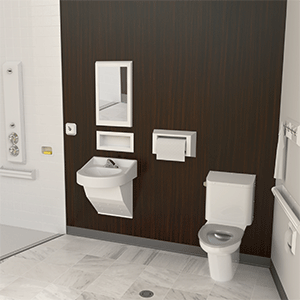
All for one
BestCare Ligature-Resistant Restroom features Universal Design principles to accommodate all people. Whitehall Manufacturing, a division of Morris Group International
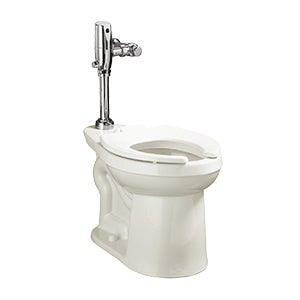
Sturdy seating
The Right Width FloWise toilet meets ADA requirements with a design to support a maximum of 2,000 pounds. American Standard
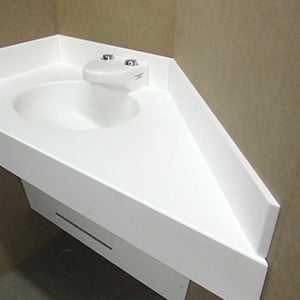
Keep it clean
This ligature-resistant metered faucet is designed to prevent the growth of waterborne pathogens such as Legionella. Norva Plastics Inc.
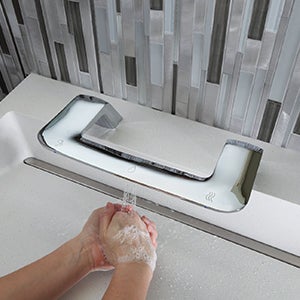
Clean design
The WashBar features a 0.5 GPM or ultra-high efficient 0.35 faucet option. Bradley Corp.
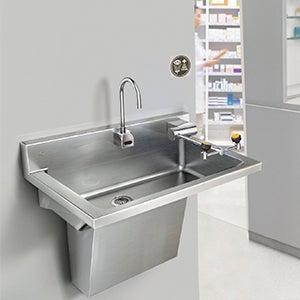
Good sense
This wall-mount handwash sink features an AutoFlow 100 degree swing-down eyewash and sensor faucet. Just Manufacturing Co.
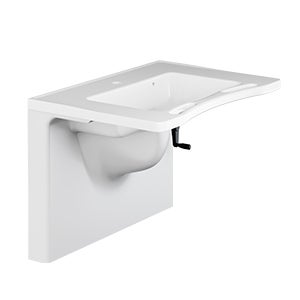
Steady hand
The Matrix M sink with bracket features integrated handrails that will not gather dirt or bacteria. Pressalit Care NA

No downtime
The Long Term Power System provides maintenance-free power for electronic faucets. Chicago Faucet Co.


